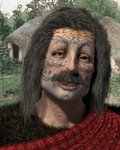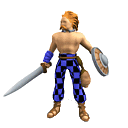The Celts |
|||||||||||||||||||||||
| Profile | |||||||||||||||||||||||
|
|||||||||||||||||||||||
|
Celtic Cities
Great Leaders
|
Background The Celts lived as extended families, or clans, which banded together, in order to form larger tribes that would occupy territory together. A Knight and a High Chieftain typically governed these tribes, while a third privileged class known as ‘men of art’, who are better known today as the Druids and Bards, extolled the feats of Celtic warriors in song and craft. Celtic society was held together by a complex web of family ties and other obligations, within which, the warrior nobles would strive to attain wealth and prestige through agriculture, trade, and success in war; which they often used to create and fund their own family or tribe. At the age of fourteen, Celt boys attained manhood and were permitted to bear arms, while girls became eligible for marriage. Young nobles and sons of freemen who reached their fourteenth birthday became clients of a famous lord or well reputed Celtic Knight. Such warrior retinues were called ‘Fianna’. These junior warriors sought out and followed experienced warriors whose success could provide them with greater chances at their own wealth and glory. The Celts previous capture and sack of Rome, headed by Brennus, also remained an indelible mark on Roman folk memory, and was likely the instigator for Rome’s merciless treatment of the Celts in subsequent wars. This mutual hostility did not cease until the Gauls and Britons were later formerly incorporated into the Roman Empire. Despite the writings and other information that paints the Celts as uncultured savages, the relatively sophisticated weapons, pottery, jewelry, and other equipment found at burial sites serves to remind us that they were in-fact very far from being the savages they were once depicted as. On the contrary, it in fact appears that the Celts maintained a rich culture that is survived by the modern Celtic and Gallic speakers of Ireland, Highland Scotland, the Isle of Man, Wales and Brittany. While the bulk of a Celtic army would typically consist of poorly armored spearmen, it was the warrior nobles who wielded swords that were the most feared. These Gallic Swordsmen were wealthier than their peers, and could afford to equip themselves not only with their slashing and stabbing sword, but also with a helmet and shield. They often charged into battle bare-chested or completely naked, occasionally wearing vividly patterned pants or cloaks. Similar to the Viking Berserker, they began their battles by viciously taunting their enemies, and followed it with a mad rush against enemy lines. This was standard behavior for skirmishes between clans, which were frequent in Celtic society. These tribal conflicts provided starting points for young Celts who sought to openly display their bravery and skill as a warrior. Celtic warriors were also known to serve as mercenaries to numerous armies of the classical period. The best known of instance of this, is when Celtic mercenaries joined Hannibal in his invasion of Italy during the 2nd Punic War, contributing to victories against Rome. In Civilization III: Play the World, the Celts are considered a Militaristic and Religious civilization, therefore, they start with Warrior Code and Ceremonial Burial, and have significant bonuses to military and cultural activities. Unique Unit: The Gallic Swordsman A Celt city must have Iron to build a Gallic Swordsman. They replace the Swordsman and are much faster.
|
||||||||||||||||||||||

 In the 1st century BC, Strabo wrote of the Celts: ‘The whole race…is madly fond of war, high-spirited and quick to battle…and on whatever pretext you stir them up, you will have them ready to face danger, even if they have nothing on their side but their own strength and courage’. Much of what we know about Celtic culture today has been derived from the insights of the various writers and geographers of the time; coupled with finds from Celtic burial sights located in Bavaria, Bohemia, and Upper Austria. The Celts once formed a loose-knit ’empire’, inhabiting territory that stretched in a chaotic band across central Europe. The writings and findings of modern archeologists place Celtic civilization as ranging from the Atlantic Coast of the British Isles and northern Spain, to as far east as Transylvania and the Black Sea.
In the 1st century BC, Strabo wrote of the Celts: ‘The whole race…is madly fond of war, high-spirited and quick to battle…and on whatever pretext you stir them up, you will have them ready to face danger, even if they have nothing on their side but their own strength and courage’. Much of what we know about Celtic culture today has been derived from the insights of the various writers and geographers of the time; coupled with finds from Celtic burial sights located in Bavaria, Bohemia, and Upper Austria. The Celts once formed a loose-knit ’empire’, inhabiting territory that stretched in a chaotic band across central Europe. The writings and findings of modern archeologists place Celtic civilization as ranging from the Atlantic Coast of the British Isles and northern Spain, to as far east as Transylvania and the Black Sea. While the bulk of a Celtic army would typically consist of poorly armored spearmen, it was the warrior nobles who wielded swords that were the most feared. These Gallic Swordsmen were wealthier than their peers, and could afford to equip themselves not only with their slashing and stabbing sword, but also with a helmet and shield. They often charged into battle bare-chested or completely naked, occasionally wearing vividly patterned pants or cloaks. Similar to the Viking Berserker, Gallic Swordsman began their battles by viciously taunting their enemies, followed by a mad rush against enemy lines. Celtic warriors were also known to serve as mercenaries to numerous armies of the classical period. The best-known instance of this is when Celtic mercenaries joined Hannibal in his invasion of Italy during the 2nd Punic War, contributing to victories against Rome.
While the bulk of a Celtic army would typically consist of poorly armored spearmen, it was the warrior nobles who wielded swords that were the most feared. These Gallic Swordsmen were wealthier than their peers, and could afford to equip themselves not only with their slashing and stabbing sword, but also with a helmet and shield. They often charged into battle bare-chested or completely naked, occasionally wearing vividly patterned pants or cloaks. Similar to the Viking Berserker, Gallic Swordsman began their battles by viciously taunting their enemies, followed by a mad rush against enemy lines. Celtic warriors were also known to serve as mercenaries to numerous armies of the classical period. The best-known instance of this is when Celtic mercenaries joined Hannibal in his invasion of Italy during the 2nd Punic War, contributing to victories against Rome.